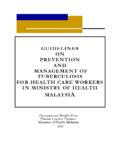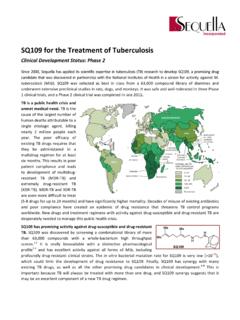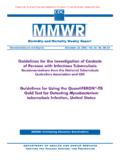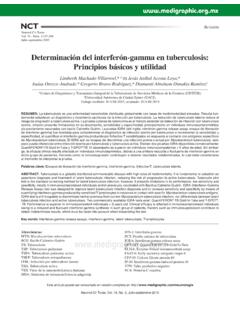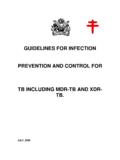Transcription of Tuberculosis and air travel - WHO
1 Tuberculosis and air travelGuidelines for prevention and controlSECOND EDITIONWHO/HTM/ World Health Organization 2006 All rights designations employed and the presentation of the material in this publication do not imply the expression of any opinion whatsoever on the part of the World Health Organi-zation concerning the legal status of any country, territory, city or area or of its authorities, or concerning the delimitation of its frontiers or boundaries. Dotted lines on maps repre-sent approximate border lines for which there may not yet be full mention of specific companies or of certain manufacturers products does not imply that they are endorsed or recommended by the World Health Organization in preference to others of a similar nature that are not mentioned.
2 Errors and omissions excepted, the names of proprietary products are distinguished by initial capital reasonable precautions have been taken by the World Health Organization to verify the information contained in this publication. However, the published material is being distributed without warranty of any kind, either express or implied. The responsibility for the interpretation and use of the material lies with the reader. In no event shall the World Health Organization be liable for damages arising from its by minimum graphicsCIP data to comeFirst edition, 1998 Second edition, 2006 ContentsPreface vAcknowledgements viiGlossary and abbreviations ixSummary 11.
3 Background information 32. Tuberculosis on aircraft 53. Practical issues in conducting investigations concerning exposure to M. Tuberculosis 94. Legal and regulatory issues 115. Reducing the risk of exposure to M. Tuberculosis on aircraft 166. Aircraft ventilation 187. Cabin air quality 208. Procedures for informing passengers and crew when exposure to M. Tuberculosis is suspected 22 Communication between health authorities and airlines 22 Criteria for deciding whether to inform passengers and crew 24 Informing passengers and crew 279.
4 Airline employee health 2810. Recommendations 2911. References 31 Annex I. Sample letter from a health authority to an airline company requesting information for contact tracing after possible exposure to M. Tuberculosis 34iiiPrefaceAir travel is now widely accessible, resulting in increasing numbers of international air travellers, with a consequent increased risk of the spread of infectious diseases carried by infected travellers. Transmission of air-borne infection between people in confined spaces such as aircraft cab-ins is of particular concern to health officials and the public at the early 1990s, there were reports of the transmission during long flights of Tuberculosis (TB) infection, including its most dangerous form, multidrug-resistant TB (MDR-TB), from contagious travellers to other passengers and crew.
5 These episodes caused anxiety among travellers and serious concern among public health officials and airline companies. The World Health Organization (WHO) published guidelines in 1998 defining the extent of the problem and the potential risks and provid-ing recommendations for travellers, physicians and health authorities and airline companies. The recommendations were based on the limited experience available at the time: investigations involving seven conta-gious TB patients and some 2600 potentially exposed air attention has been drawn to the risk of TB transmission on board aircraft, other airborne diseases have caused major international public health emergencies, in some cases involving the actual or poten-tial of transmission of infection during international flights.
6 In addition, the emergence of MDR-TB in recent years has raised special concerns in relation to the international spread of particularly dangerous strains of Mycobacterium Tuberculosis . It is therefore increasingly necessary to have clear and effective procedures in place to reduce the risk of transmission of infection on board and to ensure appropriate follow-up when revised International Health Regulations, adopted in 2005, pro-vide a legal framework for a more effective coordinated international response to emergencies caused by outbreaks of infectious diseases.
7 A number of provisions are relevant to the detection and control of TB dur-ing air travel , strengthening the authority of WHO and of national public health authorities in this of these important developments since the original guide-lines were issued in 1998, WHO has prepared this revised version to take account of current public health risks that may arise during air travel and new approaches to international collaboration in dealing with them. The guidelines were developed with the collaboration of international experts in air travel medicine and other authorities.
8 Implementing the recommendations will help to reduce the spread of dangerous patho-gens across the globe and decrease the risk of infection among indi-vidual travellers. Mario Raviglione Director Stop TB Department World Health OrganizationviTUBERCULOSIS AND AIR TRAVELA cknowledgementsThis second edition of Tuberculosis and air travel : guidelines for pre-vention and control was prepared by WHO in collaboration with the International Civil Aviation Organization, the International Air Transport Association, international experts in Tuberculosis and other infectious diseases, and leading authorities in public health and travel medicine.
9 The preparation of the guidelines was coordinated by Kwon Jun Wook. WHO gratefully acknowledges the contributions of the following:Writing committeeNigel Dowdall, Anthony Evans, Jose Figueroa, Kashef Ijaz, Susan Maloney, Lindsay Martinez, Corinne Ponce, Mario Raviglione, Claude groupL opold Blanc, Kenneth G. Castro, Dong-il Ahn, Max Hardiman, Philip Hopewell, Michael F. Iademarco, Phyllis Kozarsky, Sang-Jae Kim, Woo-jin Lew, Toru Mori, Akihiro Seita, Robert Steffen, Jeroen van Gorkom, Jane Bertherat, Neville Byrne, Keiji Fukada, Terri Hyde, Alicia Fry, Ernesto Jaramillo, William Perea, Nancy Rosenstein, Cathy Roth, Krystyna Ryszewska, Peter and abbreviationsAcid-fast bacilli (AFB).
10 R od-shaped bacteria that do not lose their stain when exposed to acid or acid alcohol mixture after the staining proc-ess, bacteria of the Mycobacterium Tuberculosis complex and all non-tuberculous crew. Personnel of an airline who are employed for duties on board the aircraft, including: cabin crew: personnel working in the cabin, flight crew: personnel working in the The dissemination of microbial aerosols to a suitable portal of entry, usually respiratory tract. (Droplets that settle out are not con-sidered to be airborne.)












